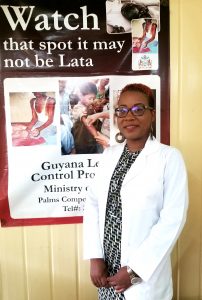By Naomi Marshall
THE Guyana Leprosy Control Programme Unit continues to progress in its effort to educate Guyanese on leprosy, a chronic disease caused by a slow multiplying bacillus called Mycobacterium leprae.
On Thursday, the unit, which forms part of the Ministry of Public Health, hosted a mascot show on the Brickdam Road aimed at addressing the stigma and discrimination attached to persons with the disease in Guyana.
The Armadillo mascot by the name of “Ardie”, took the streets with placards and music to inform persons passing by about leprosy in Guyana.
The disease, also known as Hansen’s disease, is transmitted via droplets, from the nose and mouth, during close and frequent contact with untreated cases.
However, it takes approximately five to eight years to develop while symptoms can take as long as 20 years to appear.

According to Dr Heather Morrison Wilson, Director of the Guyana Leprosy Control Programme, the armadillo is very important to leprosy research.
The armadillo is a model for the neuropathy of leprosy and potentially other neurodegenerative diseases. It allows scientists and leprologists to study the bacterium linked to leprosy, find out what new drugs can target the bacterium and do new research.
The director stated that over the years it has been observed that majority of the Guyanese population lack basic knowledge on leprosy, and as such, individuals with the disease are discriminated and not treated well.
“We have had persons with leprosy lose their jobs, so they don’t have any financial way to earn money, all because of the stigma and discrimination,” Dr. Wilson added.
However, she noted that persons with leprosy who are on treatment are not a threat to society.
“But these persons are just left and are being avoided but they actually need a lot of social support,” the doctor said, adding: “Just have an open view of these persons, they are humans just like us and they deserve to remain in their jobs even if they have a job maybe they can move from doing something physical to something else, let them substitute but don’t just knock them off.”
While Guyana, over the last three years, has been reporting over 50 new cases annually, Dr Wilson said that the increase in the amount of new cases recorded yearly is due to the unit being active and spreading awareness.
“We are envisioning that we are going to get more cases coming in because they may be afraid of the stigma or not know they have it so we tend to go out,” she stated.
Dr Wilson said early diagnosis leads to cure with without disabilities.
Within its mild stages, persons can be cured of the disease within six months, while it takes 12 months or more for persons with sever leprosy to be cured.
If leprosy is not treated early, then it may lead to the damaging of nerves which can form disabilities such as “clawing of the hands,” that are irreversible.
Signs and symptoms of leprosy includes numb spots, painful bumps, light brown spots not itching, numb hands and feet and clawing hands.
Persons who may experience the said signs and symptoms are encouraged to visit clinics in their communities for examination.
In the future, the Guyana Leprosy Control Programme Unit will be targeting schools in and out of Region Four and will be creating a fun and educational environment for the students with “Ardie the armadillo.”



.jpg)








